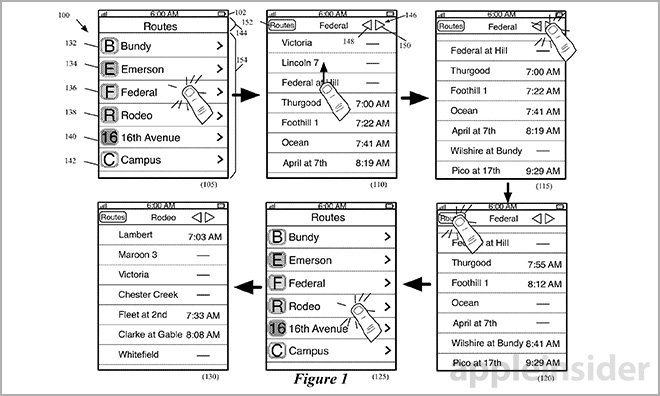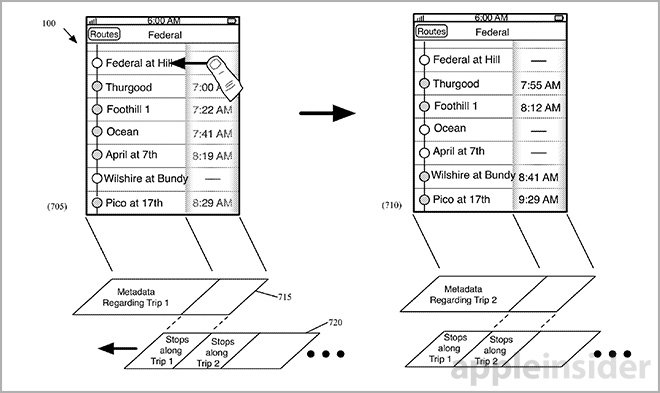Apple mass transit system for Maps detailed in new patent
Last updated
A pair of patent filings uncovered on Thursday reveal what could be Apple's answer to mass transit mapping, a highly requested feature since Google Maps was replaced in iOS by the first-party Apple Maps in 2012.
Two extensive documents published by the U.S. Patent and Trademark Office, titled "User interface tools for commute assistant" and "Location-based features for commute assistant," detail a comprehensive integrated daily commute tool, and possibly the first look at Apple's take on mass transit mapping.
Filed back-to-back, the inventions describe a user-friendly interface for viewing various mass transit services, including buses, shuttles, trains, metros and subways, on an iOS device. Airplanes, helicopters and even boats are also mentioned in the patent language, suggesting Apple is planning to create a one-stop-shop for users' commuting needs.
Everything revolves around a dynamic focus table, which is most easily described as a rolling list of transit types, routes and stops. Rolled in with physical location information is rich metadata pulled from online servers. Information ranges from schedules to route changes and, in some embodiments, advisories from third-party services.
As outlined, Apple's dynamic focus table appears to be quite flexible and easy to use, with a familiar layout modeled after current iOS lists and charts. For example, users can select a particular route, either searched for by name or offered by the device based on current location, to view trip details and other relevant information. Simple tap and scroll gestures are available for navigation.
When the dynamic table is populated with route information, users can scroll through trips and services scheduled to travel along that route throughout the day. Alternatively, time-based queries may show upcoming trips at a particular location, while yet another example allows users to browse all trips moving through a bus stop or area, irrespective of time.
In some cases, the UI is split into two distinct columns for displaying all stops along a selected route as well as their estimated arrival and/or departure time. The commute assistant is able to automatically shift focus table contents based on device location as well as time, bumping nearby routes to the top while removing others. This process can be executed dynamically, meaning users will have the most relevant routes presented to them as they continue on their trip.
Apple importantly details a so-called "Map view" in which stops, routes and other data are overlaid atop a map. Graphically, the feature looks to be similar to current implementations of user-created routes in Apple Maps, but with added capabilities that pull on metadata for upcoming trips, countdown timers for arriving vehicles and more.
As with other Apple products, the commute assistant comes with a few novel UI features that make it easier to use. An entire section of one patent is dedicated to a "Favorites" tool that allows users to set saved routes for quick recall at a later time. Another tentpole feature is side-by-side viewing of multiple routes for planning transfers or future travel.
The future of Apple's commute assistant invention is unknown, though customers have been calling for such feature to be included in Apple Maps for some time. The company is aware of the hole and previously gathered compatible transit apps in a special section of the iOS App Store.
Additionally, Apple conducted strategic acquisitions of public transit data and mapping app companies Embark and HopStop over the past two years, though assets from those purchases have yet to make an appearance in Maps. The feature was rumored for launch with iOS 8, but was ultimately not included with Apple's latest mobile OS.
Both of Apple's commute assistant patent applications were filed for in November 2013 and credit May-Li Khoe, Joseph A. Hagedorn and Marcel van Os as inventors.
 Mikey Campbell
Mikey Campbell

















 Amber Neely
Amber Neely
 Thomas Sibilly
Thomas Sibilly
 AppleInsider Staff
AppleInsider Staff
 William Gallagher
William Gallagher
 Malcolm Owen
Malcolm Owen
 Christine McKee
Christine McKee










42 Comments
Now pair this with extending apple pay into public transit.
[quote name="ECats" url="/t/183719/apple-mass-transit-system-for-maps-detailed-in-new-patent/0_100#post_2647401"]Now pair this with extending apple pay into public transit.[/quote] Not sure how keen Apple is on pearing.
I believe transit was supposed to be announced in iOS 8 but a host of personnel and management issues slowed it down. http://tinyurl.com/mkzh8tk [QUOTE]Why didn’t they appear? One tipster says it was a personnel issue: “Many developers left the company, no map improvements planned for iOS 8 release were finished in time. Mostly it was failure of project managers and engineering project managers, tasks were very badly planned, developers had to switch multiple times from project to project.”… It’s a take that is both contested and corroborated by our other source. “I would say that planning, project management and internal politics issues were a much more significant contributor to the failure to complete projects than developers leaving the group,” the source said.[/QUOTE] I'd love to see Cook hire a SVP just to run Apple's cloud business. Give this person control of maps and Siri too. Let Eddy focus on App Store, iTunes, ?TV and ?Pay.
I wonder if this will be US only, or a global thing from day 1. Apple already is asking companies to add their business info to Apple Maps: [IMG ALT=""]http://forums.appleinsider.com/content/type/61/id/53035/width/500/height/1000[/IMG] https://mapsconnect.apple.com Also for Indoor: [IMG ALT=""]http://forums.appleinsider.com/content/type/61/id/53036/width/500/height/1000[/IMG] [SIZE=1] [quote] Read Me Before Signing Up Thank you for your interest in Apple's new indoor positioning technology. We have received an overwhelming response on this service and we are prioritizing our efforts to focus on venues with the following attributes: Accessible to the general public Annual visitors in excess of 1 million per year Availability of complete, accurate, and scaled reference maps Enabled with Wi-Fi throughout Associated app is authorized by venue owner[/quote][/SIZE] https://mapsconnect.apple.com
I really have to suspect that AppleInsiders claim here that such a feature is in hot demand. I really don't see it as that big of a deal. Mass transit systems really aren't that hard to figure out really, it isn't like the rails get moved around on a regular basis. Even if we talk buses here they still run very fixed schedules. Beyond all of that the vast majority of people using mass transit are at best lemmings anyways, recycling the same route day after day after day after day. If you can run your schedule in your sleep why would you need an app?